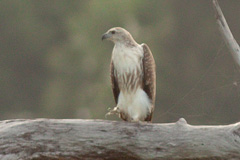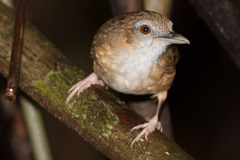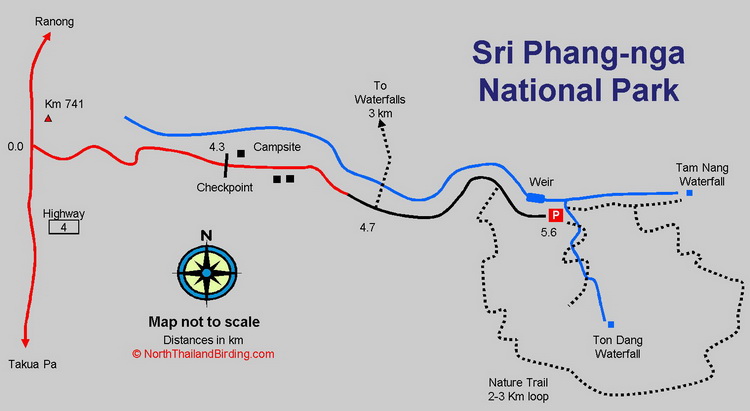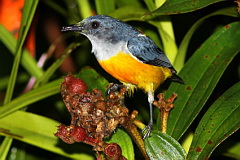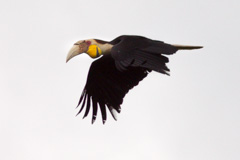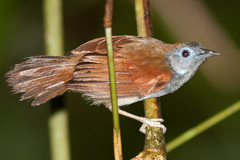Overview
Sri Phang-nga National Park, established in 1988, covers an area of 246 sq. km. stretching along the Andaman coast. As the habitat is mostly lowland primary evergreen forest - an ever increasingly rare habitat in Thailand - it provides a good opportunity to search for some difficult southern species restricted to this habitat. The park is quite relaxing and well worth a couple of days birding, and although the campsite facilities and visitor areas are fairly well maintained, trail maintenance, as always, leaves a lot to be desired. Information on this page verified/accurate as of 5 Apr 2021.
|
This is a good area for pittas, kingfishers, bulbuls and hornbills, with such specialities as Black Hornbill, Scaly-breasted Bulbul, Malaysian Blue-banded Kingfisher, Western Hooded Pitta and Malayan Banded Pitta possible. As would be expected, leeches are rife in the wet season. |
|
Access
The park is well signposted off Highway 4, about 25 kilometres north of Takua Pa along the route between Phang-nga and Ranong. When approaching from the south, the turning is found 400 metres before the Km 741 marker. Turn eastward and follow the paved road 4.3 kilometres to the entrance checkpoint.
Accommodation and Facilities
The park has a campsite plus a few bungalows. In Takua Pa a few simple hotels are available, as well as a couple of resorts along the road, both north and south of the park entrance road. The park itself has a very simple restaurant and shop selling snacks, that is reliably open during the day but not into the evening, so if camping be sure to bring supplies. The closest convenience stores are in Takua Pa.
Birding
Entrance Road
Between Highway 4 and the entrance the road winds through villages, planations and scrub. Nearer the entrance, scanning the skies can produce raptors and hornbills, especially Bushy-crested Hornbill or Great Hornbill, moving between forested valleys. Forest edge species such as Lesser Green Leafbird, Grey-breasted Spiderhunter and Orange-bellied Flowerpecker can be looked for, and the occasional Blue-winged Pitta is likely to be heard in the wet season.
|
Campsite The large clearing at the campsite sits in a valley, offering views along two forested slopes. Early morning is the best time when any of several species of hornbill might be heard or seen in the surrounding canopy, including Wreathed Hornbill, Great Hornbill, White-crowned Hornbill or Bushy-crested Hornbill. Raptors such as Wallace's Hawk-Eagle and Blyth's Hawk-Eagle occur and in winter Oriental Honey Buzzard. Trees and forest edge along the river can be checked for barbets, bulbuls, woodpeckers and similar. Access Track from Campsite to Parking Area A wide, unpaved though easily passable, track runs for just over a kilometre from the campsite to the parking area, where the main waterfall access starts. Restrictions bar vehicle access along this track before 08:00, so those wanting to start earlier will need to walk. This whole track is good birding and worth walking on more than one occasion. The track follows the river with much bamboo and primary forest. Some of the more interesting species regularly encountered include, Western Hooded Pitta, Blue-winged Pitta, Raffle's Malkoha, Red-billed Malkoha, Blue-eared Kingfisher, Green Broadbill, Hairy-backed Bulbul, Purple-naped Spiderhunter and, rarely, Malaysian Blue-banded Kingfisher. Blyth's Frogmouth occurs and Gould's Frogmouth is still occasionally reported. In the immediate vicinity of the parking area is a weir, around which Silver-rumped Spinetail and Moustached Treeswift are sometimes present. Lesser Fish Eagle is resident here as well but usually takes off as soon as the first visitors arrive. Buffy Fish Owl may be present after dark. The taller trees around the parking area are worth checking as Black Hornbill has been found, and if fruiting can attract rarer bulbuls such as Grey-bellied Bulbul or Scaly-breasted Bulbul. Waterfall Trails Just after the start of the access road is a wide trail crossing a river to several waterfalls up to three kilometres to the north. Unfortunately, having waded the river, this trail can only be followed for about 400 metres before becoming totally overgrown. No doubt, if ever maintained, this trail would pass through interesting primary habitat. From the parking area two trails can be followed to waterfalls. By far the easiest of the two is to follow the main river to the east for 600 metres to Tam Nang Waterfall where local visitors will be swimming during the weekends. |
This trail passes through good forest with Mourning Babbler, Malayan Black-capped Babbler, Moustached Babbler, Rufous-collared Kingfisher and Chestnut-naped Forktail possible. The other trail, to the south to Ton Dang Waterfall, follows a wide stream that is necessary to wade across several times, and can be deep in the wet season. Species here are similar.
Nature Trail
For those feeling very fit and adventurous it's possible to follow the Nature Trail which does a 2-3 kilometre loop through forest starting a couple of hundred metres before the parking area and ending up on the Tam Nang Waterfall trail. Much of the trail is steep, occasionally roped, and requires a good level of fitness. As few undertake this trek the chance of running into more interesting species here is higher, and certainly Great Argus is common by voice in the area. Rarer bulbul and babblers are possible such as Scaly-breasted Bulbul. Leeches abound in the wet season.
Checklist
Checklist of species.
Gallery
Additional images from Sri Phang-nga available in the Thailand Travel gallery.
Sunrise and Sunset
Detailed sunrise and sunset times.

